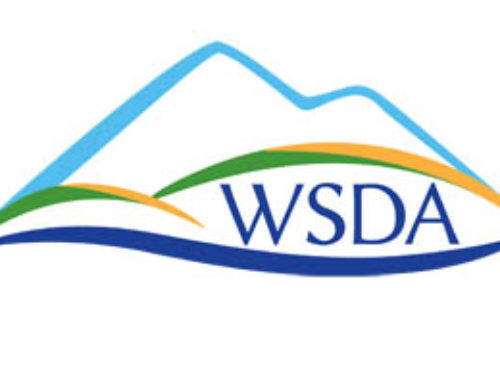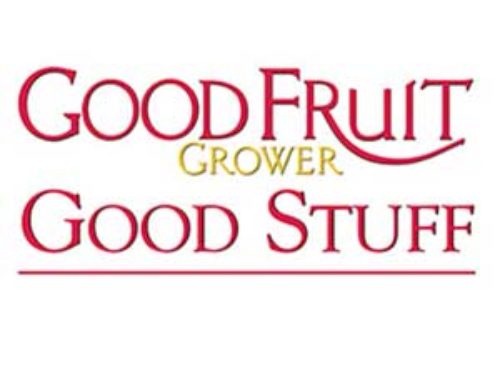
Forced-air delivery tubes positioned at individual clusters were used to heat or cool clusters to target temperatures. Wires protruding from berries measured skin temperature.
By Dr. Julie Tarara and Dr. Sara Spayd
In grapes, we know that the relationship between sun exposure and berry temperature is important to berry metabolism, composition, and by extension, wine quality. Previous research tells us that in a number of red wine grape cultivars, shaded fruit tends to have poor color at harvest, lower concentrations of anthocyanins (a class of pigments in the berry skins) and soluble solids or sugars, and higher levels of titratable acidity than sunlit fruit, all leading to a lesser-quality wine.
Warm days, for example above 86°F in controlled-environment studies, also can result in poor color development, low anthocyanin concentrations, and high malate concentrations. As vineyard managers in the Pacific Northwest adopted regulated deficit irrigation, both growers and winemakers commented on observing more “sunburn” or scald on berry skins.
Reducing the size of the vine canopy through better irrigation management may have promoted an unintended consequence: excessive exposure of berries to sunlight. Greater incidence of sunburn was reported on west-facing fruit of vineyard rows oriented north-south and on south-facing fruit of rows oriented east-west. Varietal differences do exist, and Merlot seems particularly susceptible.
Experiment
At the Irrigated Agriculture Research and Extension Center in Prosser, Washington, we set out to separate the effects of sunlight exposure from those of berry temperature on the color and composition of Merlot wine grapes directly in the vineyard rather than in a controlled-environment chamber. First, the shoots of several vines in north-south oriented rows were trained to a single side of the vine to create natural shade over this fruit and to leave the fruit on the opposite side fully exposed to sunlight.
Double-trunked vines trained to bilateral cordons allowed us to train shoots by cordon so that each experimental vine included four combinations of fruit: east-exposed to sunlight; east-shaded; west-exposed to sunlight; and west-shaded. We continuously measured fruit temperature just beneath the berry skin with fine thermocouples, and we measured sunlight at the fruiting zone of each direction-exposure combination with three-foot long solar sensors.
In a second experiment, we blew heated or chilled air onto clusters that were in the shade or fully exposed to sunlight on the west side of several vines. Some shaded clusters were continuously heated to the same temperature as untreated clusters hanging in the sun, while some sunlit clusters were continuously cooled to the same temperature as untreated clusters in the shade. This matrix allowed us to isolate the effect of temperature from that of sunlight exposure.
At harvest, the berries were analyzed by standard laboratory methods for size, soluble sugars or Brix, pH, titratable acidity (TA), total color, anthocyanins, and the phenolic compounds in the berry skins that contribute to color, aroma, and mouthfeel in wine. Both experiments were conducted in 1999 and 2000.
Results and discussion
The ripening period, from veraison to harvest, was warmer than average in Year 1 (1999) and cooler than average in Year 2 (2000). In both years, sun-exposed clusters received about 60% of full sunlight, whereas shaded clusters received only about 10% of full sunlight. There were no differences between shaded fruit facing east and shaded fruit facing west, so those berries will be described simply as “shaded,” without reference to side of the vine.
The temperature of shaded fruit was never more than 1 or 2°F (1°C) different from the temperature of the air within the canopy. Over the course of any given day, east- and west-facing exposed berries were struck by the same total amount of sunlight, only at different times of the day. Regardless of side of the vine, when the sun is most direct on the fruit, the berries can be anywhere from 7 to 24°F (4 to 13°C) warmer than air, depending on wind.
Berry temperatures were highest between 9 a.m. and 11 a.m. on east-facing fruit, and between 3 p.m. and 5 p.m. on west-facing fruit. Because air temperatures in the afternoon are much warmer than those in the morning, west-facing fruit is exposed to higher absolute temperatures than east-facing fruit. At harvest, the color of crushed berries was highest in east-facing fruit and lowest in west-facing fruit. In the warmer year, west-facing fruit had even less color than shaded fruit, suggesting not just less color development but possibly color degradation due to overheating. In the cooler year, at the time that east-facing fruit was fully colored, west-facing fruit on the same vine had barely begun to turn. Anthocyanin concentrations mirrored color: highest in east-facing fruit.
Anthocyanins primarily were related to accumulated sun exposure between veraison and harvest, secondly to heat units accumulated by the berries during that time, and thirdly to the number of hours that berries exceeded 86°F (30°C) and 95°F (35°C). The number of hours the berries were above 86°F was positively related to total skin pigments, but the number of hours above 95°F was negatively related. In other words, “warm” temperatures promote good color, but excess exposure to “hot” temperatures delays color development or degrades pigments outright, leading to the visual symptoms of sunburn.
A critical temperature for maximum accumulation of anthocyanins in Merlot could lie between 86°F and 95°F. The most important difference between the two sides of the vine was the number of hours between veraison and harvest that the fruit was exposed to temperatures above 95°F: zero for shaded fruit; under eight hours for east-facing fruit; and around 70 hours for west-facing fruit. Only west-facing fruit exceeded 105°F (40°C), but for no more than three hours during the ripening period. Regardless of side of the vine, flavonol concentrations were up to ten times greater in sun-exposed than in shaded berry skins.
There were no differences in Brix among fruit locations (east, west, or shaded). Titratable acidity was highest in shaded fruit, followed by east-facing fruit, and lowest in west-facing fruit. In all cases, pH was inversely related to titratable acidity. Ultraviolet radiation did not elevate berry temperature, but the radiation itself improved total color of the crushed berries. Total flavonols and each of the three major compounds in this group were greatly lowered when UV radiation was blocked.
None of the temperature-control or sunlight-exposure combinations affected berry size. There were some differences in Brix, but in no consistent pattern. Sun and heated-shade berries (the hottest fruit) had the lowest titratable acidity, while shaded berries (lower temperatures but very little light) had the highest titratable acidity. Temperature did not affect titratable acidity between the sunlit combinations. When crushed berries were analyzed, sun-cooled fruit (sunlit but not too hot) had the highest color and heated-shade berries (hot and very little light) the lowest color of all combinations.
Overall, color was more intense in the warmer year than in the cooler year, because larger berries diluted the whole-berry measurement in the cooler year. When only berry skins were considered, total anthocyanin concentrations across all light/temperature combinations were about 50% higher in the cooler year than the warmer year. Winemakers should note that it is not only phenol biosynthesis during ripening but also final berry size, or the skin:pulp ratio, that will influence potential color in the finished wine.
The influence of temperature on anthocyanins was determined by comparing sun berries with sun-cooled berries (same sunlight exposure, different temperatures) and by comparing shaded berries with shade-heated berries. Both comparisons yielded the same size difference in total anthocyanins, although heating the shaded berries caused no difference in the cool year because the effect of insufficient light was not overcome by raising the metabolic rates of the fruit via higher temperature. The effect of light was about the same in both years between the sunlit and heated-shade clusters.
In the cooler year, the difference between cool-sunlit fruit and shaded fruit was double that of the warm year, because ambient temperatures were low enough that what little pigment the shaded berries did synthesize was delayed. Sunlight was the overriding factor for flavonols, with three to eight times higher concentrations in sunlit than in shaded fruit. While cooling appeared to enhance flavonols in sunlit fruit during the warm year, temperature had no effect on these compounds in the cooler year.
Summary and recommendations
From these experiments, we propose that sunlight influences the composition of Merlot berries in two ways: direct solar radiation and the resulting temperature of the fruit. Although morning and afternoon sun are equally intense, berries exposed to the sun in the afternoon will be subjected to higher absolute temperatures, usually around 4 p.m., because ambient temperatures are the highest of the day.
Shaded berries remain near air temperature all day. In our experiments, only west-facing fruit bore visual symptoms of sunburn (brown patches or russeting). Shade, light, temperature, and side of the canopy did not affect berry size. Sun exposure and fruit temperature essentially did not affect Brix. Generally, titratable acidity was inversely related to the overall temperatures to which the fruit were subjected: the greater the heat, the lower the acidity. Lower concentrations of anthocyanins in west-facing, sun-exposed berries probably were due to excessive fruit temperature around midafternoon.
Pigments either formed more slowly, degraded more quickly, or both. Temperature had no measurable effect on flavonols, but light increased total concentrations of both flavonols and anthocyanins. Chilling sunlit clusters (i.e., eliminating excessive heat but allowing sun exposure) resulted in high concentrations of anthocyanins in berry skins and intense color in crushed berries, to greater effect in the cooler year than in the warmer year. Complete fruit shading is not recommended because sunlight is needed to maximize anthocyanin synthesis and to balance other wine-related compounds like acids and flavonols.
Partial shade might be provided in a vertical canopy by less aggressive shoot positioning on the west side of the canopy. Leaf stripping should be minimized in high light environments subjected to warm temperatures during the ripening period. Late-season fruit thinning could target the west side of the canopy to remove fruit that already is sunburned.





Leave A Comment